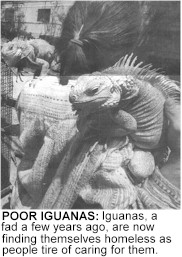
Marin Independent Journal; Tuesday, June 9, 1998
Unwanted Iguanas Trouble for L.A.
Associated Press
LOS ANGELES -- Pet iguanas used to be a big fad, but now the iguanas are big and the fad has faded.
Rescue organizations say they can't handle any more of the unwanted lizards, and the city is considering regulating their sale.
"What we really want is anyone thinking about getting an iguana to know that a 6-inch iguana could be three feet in two years," said Gini Barrett, president of the Los Angeles Animal Regulation Commission.
Joe Ventura, an inspector for the U.S.
Department of Fish and Wildlife at the Port of Los Angeles, said
about 2,000 South American iguanas come through each month,
although the number lately has tapered off. Even more come
through Miami.
Imports were driven by the development of a large Latin American breeding industry. The oversupply drove prices here down to about $20 a few years ago.
"We get two calls a day here at the zoo from people wanting to place their iguanas," said Russ Smith, reptile curator at the Los Angeles Zoo. Smith has to decline because there's no room.
"In the last couple years, it's mushroomed," he said.
The nonprofit Wildlife Waystation, an animal rescue group, has far more than 100 abandoned iguanas and won't take any more.
"We get calls daily," said Martine Colette at the Waystation in Tujunga.
Still barely domesticated, iguanas grow until they die. A pencil-length green lizard that makes a cute Christmas gift may be 6 feet long within a few years.
Iguana fanciers say they are more intelligent and responsive than other reptiles, but males can be aggressive and territorial.
Though not usually considered dangerous, iguanas have pointed teeth, sharp claws, and surging hormonal cycles. They can injure an arm simply by hanging on, Colette said, and they can move faster than people.
"They need room to roam," Colette said.